 Many moons ago, when Tony offered up these expansions for review, I braved the requisite nerd jokes and Star Trek gifs to stake my claim. I’m a lifelong Trekkie, so I’m always up for the opportunity to explore the final frontier from my tabletop. These expansions focus particularly on races and concepts from the excellent Star Trek: Deep Space Nine, which set the standard for season-spanning story arcs and character development. Tony has already written a great review of the base game, which contains the Federation, Romulans, and Klingons, so I’d recommend checking that out to learn more about the core mechanisms of the game.
Many moons ago, when Tony offered up these expansions for review, I braved the requisite nerd jokes and Star Trek gifs to stake my claim. I’m a lifelong Trekkie, so I’m always up for the opportunity to explore the final frontier from my tabletop. These expansions focus particularly on races and concepts from the excellent Star Trek: Deep Space Nine, which set the standard for season-spanning story arcs and character development. Tony has already written a great review of the base game, which contains the Federation, Romulans, and Klingons, so I’d recommend checking that out to learn more about the core mechanisms of the game.
Star Trek: Ascendancy is a space-themed 4X game, spanning an ever-expanding, modular map where classic Trek factions vie to become the most powerful civilization in the galaxy. The base game supports exactly 3 players, with each expansion adding the potential for one additional player. With experience, the game should take about an hour per player.
Expansions Overview:
The Breen Confederacy adds a new playable faction, the mysterious Breen, to the game and increases the potential player count by one. Probably the most obscure race available for Star Trek: Ascendancy, the Breen were featured in Deep Space Nine as secretive but powerful allies of the Dominion. Many Advancements grant special benefits when this civilization operates within Breen Territory, which includes all controlled systems connected to the Breen Home System. The Breen are Isolationists, so they can only exchange Trade Agreements with players who control a system adjacent to Breen Territory. Also, being aggressively Territorial, the Breen can reroll failed To Hit Rolls while in Breen Territory. So, for this faction, it pays to develop a well-guarded territorial stronghold, from which they can expand outward slowly and methodically, crushing opponents who dare to stray into Breen space.
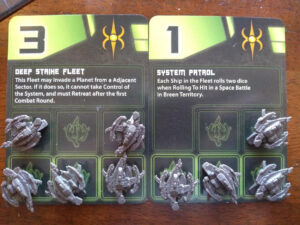
The Dominion War is a larger box expansion that not only adds the Dominion as a playable faction but also introduces a new gameplay variant that features alliances. The Dominion were the Big Bad throughout most of the run of Deep Space Nine, culminating in the Dominion War that spanned the last few seasons. In Star Trek: Ascendancy, the Dominion seek to infiltrate and dominate rival civilizations. Their Ketracel-White ability allows the Dominion player to use Commands to reroll failed To Hit Rolls in Space Battles and Planetary Invasions. The latter will be the Dominion’s primary means of gaining control of enemy systems as their Domination feature does not allow Cultural Hegemony attempts. Finally, the Dominion begin the game with Changeling Infiltrators on their Home System, The Great Link. These Infiltrators can be sent out to any system in the galaxy in order to further Dominion machinations. A number of Advancements provide benefits in systems with a shapeshifting Infiltrator.
This expansion also brings the Gamma Quadrant to games of Ascendancy. In Star Trek: DS9, the discovery of a wormhole near the planet Bajor connects the distant Gamma Quadrant to the Alpha Quadrant, home of the familiar Trek civilizations such as the Federation, Romulans, and Klingons. This bridge between quadrants is represented in-game by a special dual-system tile that contains Bajor (in the Alpha Quadrant) and Idran (in the Gamma Quadrant), linked by a wormhole. Ships must exit warp at one of these systems, then spend a Command token in order to traverse the wormhole to the other quadrant. When playing with this optional variant, the Dominion player’s Home System is located within the Gamma Quadrant. Any systems that are explored in the Gamma Quadrant come from a separate stack of planetary systems and phenomena. Connections cannot be made between systems in the two quadrants, so the only means of travel between them is through the Bajoran wormhole.
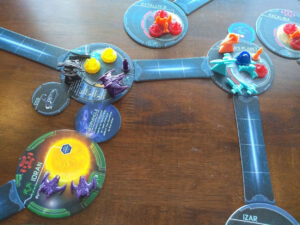
Another addition to this expansion is the Dominion War variant, which introduces team play to Ascendancy. This mode requires at least four players and works best with an even number of competitors. Each civilization will be assigned to an alliance, meaning that players on the same team must work together to achieve a shared victory. Setup differs significantly for the Dominion War as each Home System will begin the game connected to four colonized systems containing preconstructed resource nodes. Then, each player’s network will be connected to their allies’ and adversaries’ networks, creating a ring of colonized and unexplored systems. Alliances follow an alternate ruleset, forbidding combat against those on your team while allowing cooperation during space battles and planetary invasions against opponents. Additionally, Alliance Cards give players access to powerful new on-going abilities and one-time effects. A game of Dominion War is won by the alliance that conquers all opposing Home Systems.
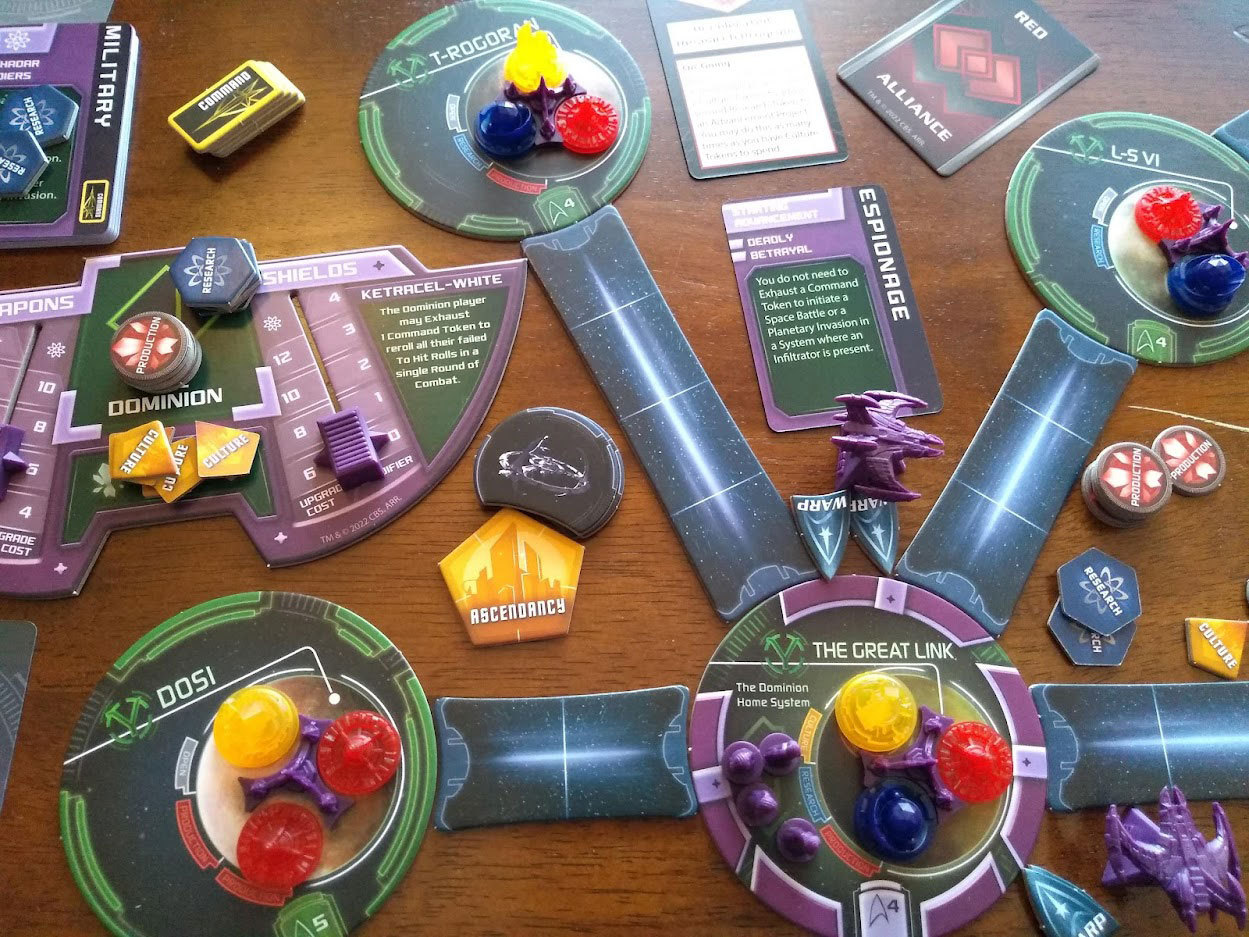
Game Experience with the Expansions:
The Breen Confederacy
Aside from the asymmetry provided by the Breen’s special abilities and playstyle, there are no new rules or mechanisms to shake up your Ascendancy games. And that’s okay. The Breen are quite fun to play, rewarding a more insular playstyle that seeks to maintain close borders and expand more gradually. Once a Breen player has built up several advancements and fleets with devastating effects, opponents will think twice about entering Breen Territory. This homefield advantage can make quick surgical strikes into adjacent systems quite lucrative for the Breen, who can retreat to their territory to weather any potential retaliation. However, the Breen don’t have great ways to generate culture, particularly if they get unlucky and don’t come across many systems that can support culture nodes in their initial explorations, making an Ascendancy victory potentially hard to come by. And since Breen fleets are most dangerous on their home turf, it can be a tall order to expect them to easily achieve a Supremacy victory by taking control of rival Home Systems. So, newer players should keep in mind that the Breen Confederacy likely won’t be the easiest faction to begin with.
The Dominion War
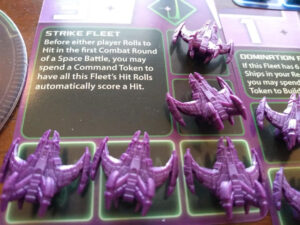
The Dominion are very combat-oriented, with numerous abilities and advancements that make them dangerous foes in battle. Like the Vulcans’ Ambassador mechanism, the Dominion’s Infiltrators allow a player to seed rival systems with non-combat units that can produce numerous benefits and advantages. Learning how to send out Changeling Infiltrators to the far reaches of the galaxy and orchestrate events in your favor from the Gamma Quadrant can make a Dominion player feel quite powerful.
The Gamma Quadrant mechanism itself is a nice option to add to games of Star Trek: Ascendancy, further pushing the modularity and variability of the space exploration system. The introduction of this galactic bottleneck pushes players to adapt their strategies of expansion to account for the threat of allowing the Dominion player to turtle up in the relative safety of the Gamma Quadrant. While a rival’s presence in one of the systems bordering the wormhole doesn’t preclude ships from traveling through, control of Bajor will likely be heavily contested in a game containing the Gamma Quadrant. This relatively simple alteration to the way that the galactic map operates in Ascendancy is a refreshing change-up to a core mechanism of the game.
But it’s the Dominion War variant that provides the greatest divergence in gameplay and has the most potential to inject novelty into your game of Star Trek: Ascendancy. Having the players divided into teams dramatically changes how you must go about playing the game. As part of an alliance, you’re tasked with cooperating and combining resources with other players in order to pursue a common goal. Personally, I enjoy the addition of this optional mode of play, and it’s certainly thematic in the context of Star Trek, where alliances such as those between the Federation and Klingons or the Dominion and Cardassians factor heavily into numerous storylines.
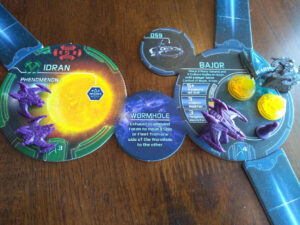
Aside from team dynamics, this variant also significantly alters the overall style of play that is likely to develop in a game of Ascendancy. Since all Home Systems begin the game linked to one another, exploration tends to be somewhat de-emphasized (particularly if you’re running out of table space). Each player’s Home System will already be connected to at least four colonized systems, so there’s less of a need to spread out early in order to build up your empire. Overall the Dominion War is a very combat-focused game mode. For those players who prefer the battle-intensive aspects of Star Trek: Ascendancy, this variant encourages you to cry “Havoc,” and let slip the dogs of war as fast as possible.
Where the Dominion War perhaps becomes bogged down is the Conquest mechanism, which introduces a lot of peripheral rules and flotsam to the gameplay. It’s obvious that the developers needed a way to deal with the possibility that player elimination could make the game fairly one-sided once an alliance successfully takes out one of their adversaries. It’d likely be a doomed slog for the team down a player and no one would have any fun, especially the eliminated player. However, I’m not convinced that the convoluted rules governing how a conquered faction must subsequently play the game were the best choice. In any case, playing as a conquered civilization is fairly uninteresting as you can’t engage anyone in combat and your production is severely hampered. You’ll basically just be playing Resistance cards and hoping that you get the chance to liberate yourself through a Rebellion.
Final Thoughts:
Both expansions bring plenty of variety and the potential for new experiences to your games of Star Trek: Ascendancy. For fans of the game, there’s no reason not to get both, particularly if you’re a completionist and/or just want to have as many faction options as possible for your group to choose from. For DS9 fans in particular, these expansions are a must as they allow you to traverse the Bajoran wormhole, explore the Gamma Quadrant, and play out the Dominion War.
If you’re only looking to add one more expansion, then it’s more about what you want out of the new purchase. Obviously, the Dominion War has more to offer in terms of additional gameplay variants. So, if you’re looking to spice up your Ascendancy plays, that’s the expansion to add. But if you just want another race to play or need the components to add one more player, the Breen Confederacy has all you need at a slightly lower price point. And for all you Breen fans out there, it’s a no-brainer, right?
The Breen Confederacy Expansion
 Hits:
Hits:
• More Stuff: A new faction and another player
• Rewards a militaristic, territorial playstyle
• Cloaking devices and energy-dampening weapons!
Misses:
• More obscure Trek race might not excite everyone
• Can be a tough faction to play
The Dominion War Expansion
 Hits:
Hits:
• More Stuff: A new faction and another player
• Introduces interesting new game variants
• Changelings and Vorta and Jem’Hadar!
Misses:
• Dominion War Conquest rules feel clunky and unexciting





















